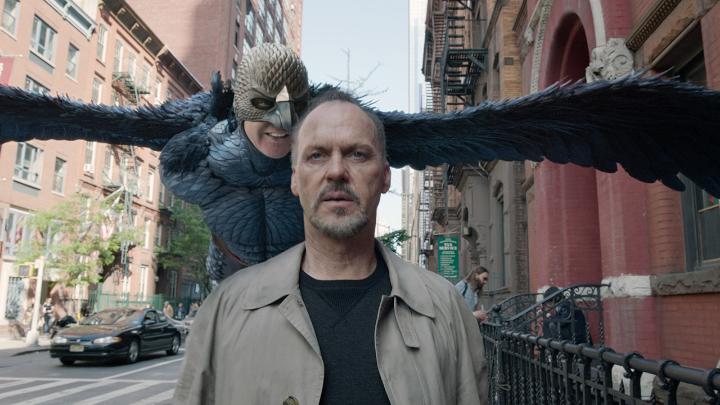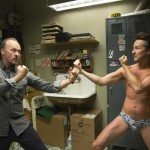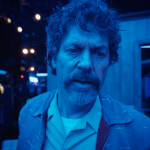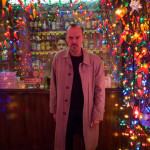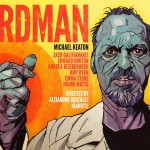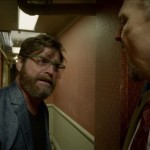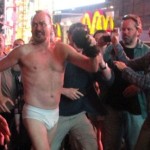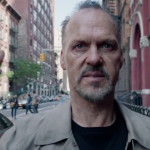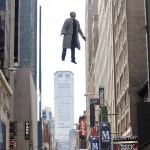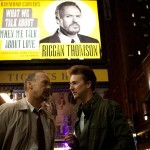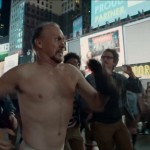The subtitle of Alejandro G Iñárritu‘s Birdman is “the unexpected virtue of ignorance” – a back-handed compliment of sorts from the acidic critic in the movie – though an alternative version might be “authenticity, truth, reality and Hollywood” since this movie is the latest shining example in a long line of wicked and knowing satires on acting, notably The Method, critics and, ultimately, Hollywood itself. As we well know, the studio heads like to send themselves up every now and again – but nothing too acerbic or close to home.
But then again, you could also choose “What We Talk About When We Talk About Love” after the Raymond Carver story of the same name, this being the story adapted by Michael Keaton‘s character Riggan Thomson into a wordy and turgid drama for Broadway in the vain hope that it will restore his flagging acting career, he being best known for three movies in which he donned the costume to appear as the eponymous superhero “Birdman.”
Birdman is not exactly Thomson’s alter ego since he does not lead the double life of a superhero, but arguably the id fighting to get ascendency over his super-ego, for those familiar with the Freudian model of the psyche. But his inner voice does try to tell him he is better than this and should be making action movies again so audiences can love him for the man he used to be, which power is exemplified through telekinetic powers Thomson keeps to himself and uses largely to trash his dressing room, pacified by his lawyer and friend Jake (Zach Gailifianakis) and in turn by his recovering addict daughter Sam (Emma Stone) – though even she turns on him in the end.
Later Birman comes out of hiding and demonstrates to Thomson that he can do anything, including flying (seriously folks, don’t try this at home) – but we know that none of this is the reality Thomson seeks, merely his deluded mind slowly losing grip on reality. Or is it? The irony is that after a botched stage suicide (more in a moment), Thomson’s glorious flight may yet take him to Birdman 4, the role he declined 20 years before. Sound familiar?
Thomson’s nemeses come firstly in the form of brilliant method actor Mike Shiner, brilliantly played by method actor Edward Norton as a fragile ego in search of the truth and authenticity his real life lacks. Yep, Shiner’s stage personality really is his alter ego. Psychoanalysts would have a field day with this movie!
Shiner is outrageous in his endless quest for authenticity, even putting in Thomson’s mind that he did not feel threatened by the toy gun used on stage and almost raping his girlfriend, actress Lesley Truman (Naomi Watts) on stage. Not content with his minute hunt for motivations in the text, Shiner breaks out of character at a preview to complain that gin has been replaced by water, tears the set apart and sets about screwing up every relationship, including Thomson’s with Sam.
The other dagger in Thomson’s heart is arch critic Tabitha Dickinson (Lindsay Duncan, whose husband Hilton McRae I saw recently in Uncle Vanya), an ice maiden whose blood runs thick with venom due to her hatred of all that is Hollywood. Dickinson threatens to use her vituperative column to kill Thomson’s play on the first night. Driven by this criticism, Shiner’s rants and the endless Birdman monologue within him, Thomson takes a real gun on stage and… shoots off his nose. The bitter ironic twist is that this action wins him rave reviews and Jake grandly suggesting they could offer him further new noses if the replacement does not suit him.
Apart from a few brief forays into Times Square and Manhattan, the action here is contained within the gloomy corridors deep in the bowels of the St James Theatre, the seedy dressing rooms, the stage and auditorium itself, even the parapets make an appearance as if Quasimodo were suddenly to appear crying “the bells, the bells.” The actor in me felt very familiar with the shabby backstage scenes, a wonderful reminder that this is all about putting on a show, creating a credible façade on which the audience can suspend its disbelief.
Whether you believe actors also talk offstage in fully-formed epigrams like characters in a David Mamet or Edward Albee play is another question entirely, this being an even wordier show than the one they are attempting to put on for the paying public. Watching them chew the fat at length is arguably the one factor likely to put viewers off this movie, though with typical knowing, Iñárritu sends himself up as Birdman eschews talking in favour of explosions, monsters and assorted action shots – thereby exposing our own dilemmas.
Personally I’d sooner go for educated and eloquent movies that attempt intelligent conceits, though here even CGI special effects are cunningly used to underline the underlying theme (see section from Wikipedia at the bottom), and even more impressively there are loose ends and ambiguities. I quote from Wikipedia:
The director has emphasized and defended the various ambiguities intentionally included in the film: “At the ending of the film [it] can be interpreted as many ways as there are seats in the theater.”
Nice sense of humour, Alejandro – though there are several scenes offering a wry and downbeat chuckle in a way that reminded me slightly of the Coen brothers’ inscrutable Inside Llewyn Davis. The nearest it comes to slapstick is where Thomson finds himself locked out of the theatre, so walks around and through Times Square dressed only in underpants, in order to make his scheduled entrance to the preview from the back of the theatre. Small wonder he later moans about how the production is following him around, though he only has himself to blame for a mock punch-up with Shiner.
In short, a clever movie, and beautifully played too – but then actors do enjoy the opportunity to build characters as fully-functioning 3D flesh and blood entities rather than the cardboard cutouts so popular in the superhero movies Birdman the character represents.
Fair to say that, let off the leash more than directors have typically allowed him, Keaton gives the performance of a career – in fact, compared to the comedic roles that won his name this is the first weighty performance I can recall him giving time and space to show his craft – even though Norton very nearly steals his thunder. At times it is big, brash, flashy acting for the hell of it, but counterbalanced by sufficient light and shade that you can forgive the occasional moments of excess.
Interesting and ironic then that the film won four Oscars – best film, best director, best screenplay and best cinematography – but not a single one for the cast. You pays your money and you takes your choice…
___
Post-production and visual effects
Birdman was edited by Douglas Crise and Stephen Mirrione, who had both worked with the director before on 21 Grams and Babel. Stitching shots together was, of course, a crucial component of the editing, but Crise and Mirrone already had experience doing this. The director had included takes that were joined together in previous films, but in these if the editors didn’t think the stitching worked they had the ability to introduce cuts. Mirrone said that in Birdman Iñárritu had “let go of that safety net”. Because of this the editors needed to be involved in the project early on, and during principal photography Crise was on set every day. (Mirrone was busy so unable to be in New York.) Crise was not used to being on set and providing feedback, but said he was happy Iñárritu “dragged it out” of him, knowing that they wouldn’t have much room to fix scenes later so needed to get them right. For stitching, aside from the director Crise also discussed strategies with Lubezki and Thompson, and techniques for gluing takes together included panning on walls and actors’ bodies. The editors were used to being able to adjust the rhythm of a scene by the positioning of cuts, so without this tool used Sánchez’s music instead. The director gave the New York recordings to Crise early on to help with pacing, asking him to cut the music to the film. Still, in terms of the editing workflow, Crise described it as “pretty traditional”. The editors cut the film together back in Los Angeles. A few weeks after shooting they were quite far along the cut itself, and transitioned into visual-effects mode, where they fine-tuned the shots.
“ They always talk about how when you’re cutting a dance scene, a choreographer wouldn’t want any cuts because she’s designing something to see the whole movement, and that’s what Alejandro was doing here. ” The visual effects for the film were created by Montreal studio Rodeo FX. They spent four months working on the film, and according to visual effects supervisor Ara Khanikian “visual effects touched 90% of the frames in the movie.” A lot of the work was subtle. For example, stitching shots together, or creating the background for the windows in the hospital scene. Many shots in the film feature mirrors, and much work was spent removing the reflections of the crew from these. To accomplish this the studio created a 2.5D digital matte painting of the reflected environment. They then rotoscoped out the parts of the mirror not containing the foreground actors and their reflections, and replaced these with the digital environment. Some of the original shots captured smudges and dirt on the mirrors, so the studio developed a way to extract them so they could paste them back into the film. A matte-painting was constructed for the night-day time lapses in the film too, created by matchmoving and reprojecting shots of the buildings it features, captured at different times of the day, together. Rodeo FX also adjusted the pace of scenes. Iñárritu demanded a “very precise rhythm and flow” to the film, so the studio had to re-sped much of it with timewarp curves to fit the pacing the director desired.
Unlike some of the smaller adjustments though, the flying sequence required extensive preparation. Iñárritu spent three weeks with Halon Entertainment to previsualize the sequence. In New York, Lubezki then used the choreography of the previsualization to shoot background plates for the sequence, using a camera crane on a truck. When these were shot, Lubezki had mounted four GoPro cameras to the lens of the film camera to capture the light environment around him. Later, on a greenstage in Montreal, using a technique he had developed on Gravity, Lubezki lit Keaton with LED panels featuring high-dynamic-range images of the surrounding New York footage. The panels then realistically lit Keaton. Khanikian described the effect of the process, saying “instead of using standard lighting on greenscreen [we were getting] the proper red bounce from the red bricks and the same color of the sky reflected on Michael’s head. It worked so well.” Rodeo FX then completed the final shots. The sequence was the last piece the editors inserted into the film. Mirrone commented that before the sequence was finished they “had only imagined what it was going to feel like”, but once it was completed “it took the movie to this ecstatic level that absolutely blew me away.”
Sound design for the film was handled by Martín Hernández, who has worked on all the director’s feature films. The production sound his team was given was “surprisingly perfect and clean”, so they didn’t need to spend much time tidying it.The lack of visual cuts in the film meant a departure from the usual way Hernández edited sound though. “Normally Alejandro likes, as he calls it, ‘the clashing of the sounds.’ The camera changes angle within the scene and there is a change of everything – backgrounds, texture, dialog. Obviously, that would not work on Birdman because here, everything is flowing.” Additionally, the sound of objects in the film needed to be coordinated with their position onscreen, a non-trivial task since the camera was nearly always moving. Hernández also helped to cut Sánchez’s tracks, selecting and editing moments from the New York recordings against the film. When the tracks were re-recording in Los Angeles, in order “to have distance, and closeness and resonance” the team used thirty two microphones for each take. Hernández described the job as “crazy”. A large challenge of the post-production soundwork was designing the sound of the theatre audience, particularly in the scene when Mike is drunk and comes out of character. Iñárritu knew how he wanted the audience to respond, but figuring out the sound of their reaction took four months of work from five sound designers. Hernández said he thought, for a film in general, that the narrative created by sound “provokes more ‘explosions'” than that created by images, and that in Birdman “Alejandro has sound exploding all throughout the film.”
The digital intermediate was completed by a team at Technicolor led by Steven Scott. They had previously collaborated with Lubezki on Gravity, but needed to approach Birdman differently because of the continuous-shot approach. According to Scott, “we have never done anything like it before.”[68] The color timing had to be done in such a way that the transitions between color-corrected environments were invisible, in contrast to a usual film where the transitions coincide with visible cuts. To do this, the team inserted their own cuts whenever the camera was stationary, and in the middle of pans and other camera movements. They then devised a way to color correct the stationary cuts and turn the moving cuts into a form of dissolve, allowing them to “do all these independent, crazy, complicated, color corrections that would flow organically from one to another.” Inserting the dissolves required rotoscoping methods which the software Scott and his team were using did not have, but an enterprise agreement between Technicolor and the software’s developer led to the creation of a tool Scott required. For the color timing itself, one of the priorities of the team was making the faces as dimensional and readable as possible. This required, amongst other things, that faces be highlighted, but the moving camerawork meant that the mattes used in this process had to be animated by hand. Lubezki would provide notes on the areas he wanted tracked, then the team would carry out the animations. Of the whole process, Iñárritu remarked that “everyone was out of their comfort zone”, while Scott said it was the most challenging DI project of his career.

